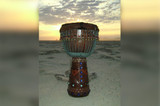Which Djembe for Classrooms? Modern or Traditional?
Solomon Masala specializes in training teachers and developing programs that utilize drums in classrooms to facilitate learning. In this video he discusses the djembe drum which is an essential instrument used in many of the lesson plan activities. Teachers and administrators should understand the types of djembes available and what models are best for classroom use.
One of the distinctions we want to make with respect to djembe drums, which are some of the most popular drums available today, is the difference between the traditional djembe and the modern djembe. A few of those elements include the fact that the traditional djembe is made out of natural materials. They've been this way for hundreds of years. They have a wooden shell, often wonderfully carved, and a natural animal head (typically goatskin) and are tuned with rope using the Mali-Weave tuning pattern. They are wonderful drums that sound and look fantastic. You can get them in a variety of shapes and sizes available at various price points.
Remember though that we're looking for drums to use in the classroom. That's why we instead recommend the modern djembe. First, whereas the traditional djembe is made out of a wooden shell, the modern djembe is typically made out of some other synthetic material, in this case fiberglass. Fiberglass drums are extremely durable and will not crack from either weather variations or from the drum being dropped/knocked over which can sometimes happen in a classroom. The other thing is that the head of the djembe is made out of a synthetic material. In this case it's made out of Mylar and still gives it a nice warm, soft feel as far as the sound goes so it very much mimics the natural skin head. However, if you happen to turn your head (no pun intended) for a moment and a student whacks the drumhead with a drumstick the goatskin is going to pop. The synthetic head is going to maintain its structural integrity, in other words it's not going to break for a quite a long time.
If for some reason you do end up with a natural goatskin that is broken you're going to have to learn how to do all of this roping and un-roping so you can get the head off and replace it. This can take a long time! The beautiful thing about the modern mechanically tuned djembe is that if you ever need to replace the head all you have to do is simply use the little tool (wrench) that comes with the drum. This is how you tune it as well and in just a matter of seconds I can tune this drum. And if I need to change the drumhead it's just a matter of pulling off the nuts all the way around the drum, popping off the head, putting on the new head, and tightening it back up. This takes a fraction of the time to replace the head when they do break, which they rarely do.
So, again the difference between the traditional drum and the modern drum include the shell and the shell durability, the head and the head durability because one is natural and the other synthetic, and the ease of being able to tune them mechanically and change the head. So while traditional drums are great for personal usage, we recommend the modern djembe for use in the classroom because it has a synthetic shell, a synthetic head, and a mechanical tuning system.
---------------
 Classroom instruments developed by X8 Drums and Kenya Solomon Masala.
Classroom instruments developed by X8 Drums and Kenya Solomon Masala.
Sharing his love of rhythm and drumming within corporations, classrooms and communities, Solomon Masala is a recognized and respected trainer and facilitator across the country. Masala's original Rhythm Play!™ activity book and X8 Interactive drumming programs introduce activities that integrate music within classroom and team development environments, and are accessible to teachers, educators and facilitators through easy-to-teach lessons that are adaptable to the ages and abilities of students and participants.
X8 Drums has worked with Solomon to develop musical instruments specifically for classroom settings. These instruments have been field tested and are ready for years of use, travel and can withstand wear and tear.
The latest additions to the Classroom Instruments are the Twister Drum (a collapsible djembe drum) and the Masala World Rattle.
Recent Posts
-
What is the Best Size Djembe for Beginners?
If you're new to the world of percussion and interested in learning the djembe, you're in for a t …16th Jul 2024 -
The Benefits of Becoming a Drumming Teacher: Transforming Passion into Profession
Why become a drumming teacher? Becoming a drumming teacher is an excellent way to share your pas …22nd May 2024 -
What Makes the Djembe Drum a Spiritual Instrument in African Music?
Origin and history of the Djembe drum The Djembe drum originates from West Africa and holds sign …16th May 2024



